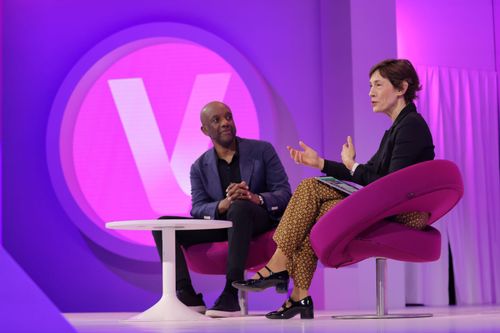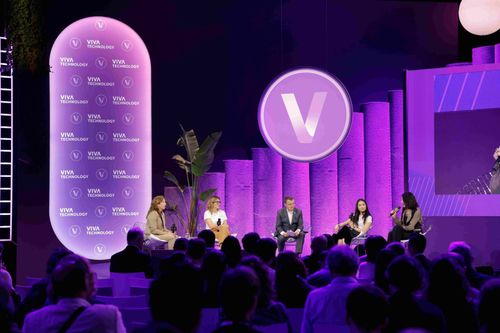Busy city street intersection. Photo credit: Deva Darshan
The pandemic has caused a paradigm shift in the way people move. New work habits and a preference for proximity have increased the popularity of electric and micro-mobility solutions in cities around the world. This shift has caused professionals and consumers alike to start asking: What will tomorrow"e;s urban landscapes look like And what are the implications in terms of mobility We sat down with a panel of mobility experts during VivaTech to discuss the evolving mobility trends and how urbanists and service providers can work together to achieve efficient and green urban mobility.
The discussion started off with an introduction to urban mobility with Ellen Dunham-Jones, Professor and Director of the MS in Urban Design at the Georgia Institute of Technology and was followed by a panel made up of Sampo Hietanen, founder and CEO of MAAS Global; Lawrence Leuschner, CEO and Co-founder of Tier Mobility; Oren Ezer, CEO of Electreon; and Alexander D’Orsogna, Head of Business Development at Volocopter.
Panel discussion with Hietanen, Leuschner, Ezer, and D’Orsogna. Photo credit: VivaTech
Back to our routes
When it comes to changing how we move and what the future holds for the mobility industry, our experts invited us to look back at how our cities have evolved into their present-day set up. Up until the invention of the automobile, cities and towns were built mainly around town halls, religious buildings, and gathering places. But over the decades following the marvelous invention of the car, cities have evolved to include more and more space for vehicles and less space for pedestrians and bike-users. And our public actions have changed in reaction to these spaces as well. “People are no longer the friendly neighbor type; we are now competitors on the road, battling for road space and for parking space,” stated Dunham.
What used to be a pleasant stroll down the road, has now become a stressful and tiresome drive. As Leuschner put it, driving in a city is not safe, it’s loud, it’s not joyful, you are always in traffic jams, and it"e;s 10x more polluting than a bike. “We are trying to emphasize the idea that using a car in a city is pointless. Obviously in the countryside it is different, and even necessary, but for cities, there are better options. Driving a two-wheeler is much more practical.”
So this begs the question, why do we still use cars in cities With a plethora of public transportation and ever more popular micro-mobility options, it seems the “need” for a car within a city should be dwindling.
Hietanen weighed in to talk about this dependence on cars. “Everywhere I go, all these cities want to reinvent the city, less cars, make it better for the environment, more sustainable, etc. But no one dares to ask the question ‘What would it take, for all of you, to give up your personal car’ Is there something better The car has dominated the market for 100 years because it’s not just a car, it’s a symbol of freedom. Your personal freedom. Being able to go anywhere, anytime, on a whim. So if we aren’t trying to tackle this or find a solution, we’re just kind of skirting around the real problem. And this is the biggest problem to solve for our cities, for our economic growth, for sustainability.”
Making space for grass in urban areas. Photo credit: Caio
Human-centered cities
So, if leaving car-centered cities behind is the goal, what needs to change Or even further, what do people want from a more human-centric city$7 Less asphalt, more green spaces. Less overbearing structures for transportation, more open air. Less pollution, more sustainable transport options. Basically, a return to a more local way of life, with more nature involved in our very urbanized environments.
Our panelists mentioned the idea of the 15-minute city, a concept that the Paris mayor, Anne Hidalgo, popularized. The concept is based on the idea that most daily necessities should be accomplished by either walking or cycling from residents"e; homes – gone would be the days of long commutes to get to shopping centers or doctors offices on the other side of town.
While the concept is a great idea, its implementation in different parts of the world is easier said than done. Restructuring cities overnight is quite impossible and many solutions need governmental support or approval. But our mobility experts don’t think we’re doomed to stay where we are. In fact, city structure changes might start with our four panelists and their companies themselves.
Visions for an interconnected future
Our panel members are all part of the mobility industry, yet they each have their own solutions to propose for its future. Let’s dive into their ideas.
The micro-mobility revolution
Leuschner’s company, Tier Mobility, is Europe"e;s leading shared micro-mobility provider, and has a mission to Change Mobility for Good. With his goal to give city space back to the people, Leuschner believes that it all starts with finding an alternative to cars.
“We believe that micro-mobility will be a catalyst for completely disrupting the cities. At the end of the day, people are selfish, and want to go from A to B whenever they want. So we want to play a part in that by offering bikes, scooters, etc. which are more economical, more sustainable, and more joyful than a car and in the end leads to more people-centric cities.”
Photo credit: Tier Mobility
An all-in-one ecosystem
Not quite a believer that the car should be scrapped all-togather, Hietanen has included cars in his business model, but goes far beyond personal car ownership. MAAS Global Ltd. is creating the world’s first mobility ecosystem. A single app that allows people to travel as much as they like with a flat fee, or pay-as-you-go, with buses, trains, taxis, bikes, cars and more.
“People are lazy and we are individualists. So we need to offer solutions that do not jeopardize your personal freedom. Right now in Europe, there are 70 million EU citizens looking for an alternative to car ownership today. And I think that we as an industry suck if we cannot provide that to them.”
Photo credit: Whim
Roads that charge as you go
With electrical vehicles becoming more and more popular, whether for personal use or for public transport like buses or trams, Ezer’s company Electreon is creating an ingenious solution for charging these vehicles. Their wireless charging technology enables any electric vehicle to charge whilst driving or stationary on Electreon’s Electric Road Systems, which are simply installed beneath the road’s surface.
“We need to have more dedicated bus and public transport lanes in cities, and there needs to be better infrastructure for charging. Everyone plans on charging their vehicles overnight, but the electrical grid will become overwhelmed. So we need solutions that offer charging capabilities during the day as well.”
Photo credit: Electreon
Passenger Drones
In a completely other ballpark for the future of mobility solutions, we have Volocopter, where D’Orsogna is hoping to get city-dwellers off the streets completely. Volocopter’s family of eVTOL aircraft are building the foundations to offer passengers and goods swift, secure, and emission-free connections to their destinations.
“What we are doing with our eVTOLs is focusing on flying over city centers to bring people from point A to point B in a fast, sustainable, clean environment.”
D’Orsogna also stated that Volocopter is planning on having their passenger drone services in place in Paris before the 2024 Olympic Games.
Volocopter. Photo credit: VivaTech
United in the revolution
What’s certain is that there are many solutions out there and a plethora of people trying to make this urban mobility revolution possible. From our panelists on the stage to startups that exhibit on the VivaTech floor and beyond, urban mobility is starting to change for the better.
Yet what can we do as consumers to help this revolution$8 “It begins with asking yourself, how can I contribute to a net zero city,” Leuschner said. “Be vocal in your local communities and advocate for creating more space for micro-mobility. Ask, how can I engage my friends to challenge what we believe and how we move in cities to create a more sustainable world. Be thought leaders in your community.”
If you want to watch the full session, you can watch the replay on our Digital Platform here!


